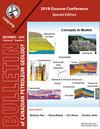Quantitative seismic interpretations to detect biogenic gas accumulations: a case study from Qaidam Basin, China
Q3 Earth and Planetary Sciences
引用次数: 3
Abstract
Abstract Quantitative seismic interpretation can be used to identify lithology and detect petroleum accumulations by integrating rock properties and attributes derived from advanced seismic inversion methods with existing petrophysical data and geological knowledge. We use quantitative seismic interpretations for detection of shallow biogenic gas accumulations in the Qaidam Basin, China, employing an integrated workflow that incorporates petrophysical data, seismic attribute analysis, Constrained Simultaneous Inversion (C-SI) and Bayesian-based Support Vector Machine (B-SVM) inference. Previous petrophysical studies have shown that it is challenging to effectively identify gas-bearing intervals using parameters such as impedance, Poisson’s ratio and porosity, because the reservoir sediments are unconsolidated and at shallow depths. The resistivity well-log response remains as an effective tool for estimating gas saturation and identifying gas-bearing intervals. In this study, we propose the use of the petroleum pore-volume, which is defined as the product of reservoir porosity and gas saturation, to detect biogenic gas accumulations seismically. Rock properties inferred from seismic inversion, such as compressional velocity (Vp), shear velocity (Vs) and density, cannot be used directly for petroleum pore-volume estimation. Therefore, we employ a Bayesian-based support vector machine approach to cross-link well-log properties, seismic AVO attributes and seismic rock properties to quantitatively predict petroleum pore-volume in 2D and 3D seismic dataset. Because seismic information is crucial to statistical inference, we propose C-SI to infer the Vp, Vs and density from seismic elastic impedance gathers, which can be generated from seismic gathers using a traditional recursive seismic inversion method. The C-SI procedures use the Interior-Point algorithm to optimize and solve elastic impedance equations. The Interior-Point method is a popular method for handling constrained non-convex, non-linear optimization problems that involve simultaneously inverting the seismic properties with thousands of seismic samples. This case study indicates that the integrated study workflow is useful for quantitatively predicting petroleum pore-volume, especially in the depth-domain, and that it is an excellent potential indicator for biogenic gas accumulations in complicated geological settings.柴达木盆地生物气成藏定量地震解释研究
通过将先进的地震反演方法得到的岩石性质和属性与现有的岩石物理数据和地质知识相结合,定量地震解释可以用于识别岩性和探测油气聚集。采用岩石物理数据、地震属性分析、约束同步反演(C-SI)和基于贝叶斯的支持向量机(B-SVM)推理相结合的综合工作流程,对柴达木盆地浅层生物气聚集进行定量地震解释。之前的岩石物理研究表明,由于储层沉积物疏松且深度较浅,因此利用阻抗、泊松比和孔隙度等参数有效识别含气层段具有挑战性。电阻率测井响应仍然是估计含气饱和度和识别含气层段的有效工具。在本研究中,我们提出利用石油孔隙体积(定义为储层孔隙度与含气饱和度的乘积)在地震中探测生物气聚集。由地震反演得到的岩石性质,如纵波速度(Vp)、剪切速度(Vs)和密度,不能直接用于石油孔隙体积估算。因此,我们采用基于贝叶斯的支持向量机方法,将测井属性、地震AVO属性和地震岩石属性交联,定量预测二维和三维地震数据集中的石油孔隙体积。由于地震信息对统计推断至关重要,我们提出用C-SI方法从传统递推地震反演方法可以从地震聚集产生的地震弹性阻抗集中推断Vp、v和密度。C-SI程序使用内点算法来优化和求解弹性阻抗方程。内点法是处理约束非凸非线性优化问题的一种常用方法,该问题涉及同时反演数千个地震样本的地震特性。实例研究表明,综合研究流程可用于定量预测石油孔隙体积,特别是在深度域中,是复杂地质条件下生物气聚集的潜在指标。
本文章由计算机程序翻译,如有差异,请以英文原文为准。
求助全文
约1分钟内获得全文
求助全文
来源期刊

Bullentin of Canadian Petroleum Geology
Earth and Planetary Sciences-Geochemistry and Petrology
CiteScore
2.50
自引率
0.00%
发文量
0
期刊介绍:
The Bulletin of Canadian Petroleum Geology is a peer-reviewed scientific journal published four times a year. Founded in 1953, the BCPG aims to be the journal of record for papers dealing with all aspects of petroleum geology, broadly conceived, with a particularly (though not exclusively) Canadian focus. International submissions are encouraged, especially where a connection can be made to Canadian examples.
 求助内容:
求助内容: 应助结果提醒方式:
应助结果提醒方式:


